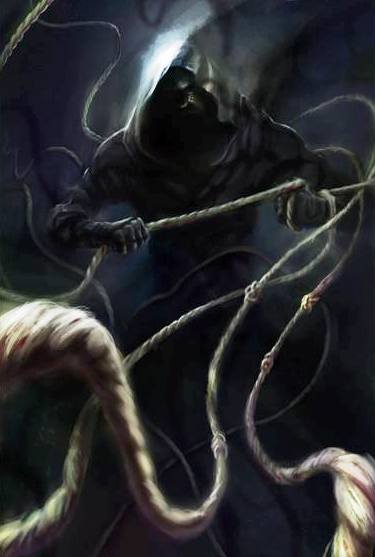Difference between revisions of "Tie (cantrip)"
Tao alexis (talk | contribs) |
Tao alexis (talk | contribs) |
||
| (5 intermediate revisions by the same user not shown) | |||
| Line 1: | Line 1: | ||
| − | '''Tie''' causes the loose ends of a rope or | + | [[File:Tie (cantrip).jpg|right|490px|thumb]] |
| + | '''Tie''' is a [[Cantrip|cantrip]] that causes the loose ends of a rope or like material to entwine itself securely around a designated target chosen by the caster. With the failure of a saving throw, the tie renders the chosen entity immobile and incapacitated until the magical binding is relaxed. The process happens in just 6 or 7 seconds. Chain and other like non-fibrous materials cannot be employed by the cantrip. | ||
{{Spelltable | {{Spelltable | ||
| Line 8: | Line 9: | ||
| casting time = 2 [[Action Points|action points]] | | casting time = 2 [[Action Points|action points]] | ||
| save = negates | | save = negates | ||
| − | | level = cantrip | + | | level = [[Cantrip|cantrip]] |
}} | }} | ||
| − | + | [[Saving Throws|Saving throws]] are made at +2, and if successful indicates that the creature was able to evade the cantrip's effect. At that point, the failed tie drops to the floor at the end of the caster's turn, ceasing to be animated. | |
| − | The | + | == Degree of Binding == |
| + | The degree to which the target becomes bound is contingent upon the available length of the material. The spell gives precedence to ensnaring the recipient's wrists and other limbs crucial for manipulation, followed by those required for locomotion. | ||
| − | + | Any surplus length, if present, is utilized to affix the target to the nearest object that's nearby. For example, this might involve securing the individual to the chair they were seated in at the time of the cantrip's casting. | |
| − | The cantrip | + | The cantrip has a proven versatility in cases such as mooring a boat to a dock, fortifying doors, fastening cargo onto an animal's back or harnessing a horse among other uses. The caster retains the ability to determine the amount of binding required, allowing for a level of restraint that's less than the maximum capacity permitted by the spell. |
| − | See [[Useful Cantrips]] | + | See also,<br> |
| + | [[Entangle (spell)]]<br> | ||
| + | [[Useful Cantrips]] | ||
| − | [[Category: Cantrips]][[Category: | + | [[Category: Cantrips]][[Category: Reviewed]] |
Latest revision as of 23:04, 15 October 2023
Tie is a cantrip that causes the loose ends of a rope or like material to entwine itself securely around a designated target chosen by the caster. With the failure of a saving throw, the tie renders the chosen entity immobile and incapacitated until the magical binding is relaxed. The process happens in just 6 or 7 seconds. Chain and other like non-fibrous materials cannot be employed by the cantrip.
| Range | 10 ft. |
| Duration | permanent |
| Area of Effect | 1 creature or object |
| Casting Time | 2 action points |
| Saving Throw | negates |
| Level | cantrip |
Saving throws are made at +2, and if successful indicates that the creature was able to evade the cantrip's effect. At that point, the failed tie drops to the floor at the end of the caster's turn, ceasing to be animated.
Degree of Binding
The degree to which the target becomes bound is contingent upon the available length of the material. The spell gives precedence to ensnaring the recipient's wrists and other limbs crucial for manipulation, followed by those required for locomotion.
Any surplus length, if present, is utilized to affix the target to the nearest object that's nearby. For example, this might involve securing the individual to the chair they were seated in at the time of the cantrip's casting.
The cantrip has a proven versatility in cases such as mooring a boat to a dock, fortifying doors, fastening cargo onto an animal's back or harnessing a horse among other uses. The caster retains the ability to determine the amount of binding required, allowing for a level of restraint that's less than the maximum capacity permitted by the spell.
See also,
Entangle (spell)
Useful Cantrips
